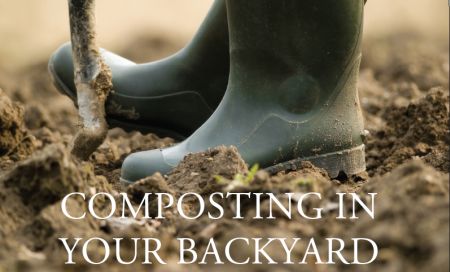
Composting is nature’s own way of recycling yard and household wastes by converting them into valuable fertilizer, soil organic matter, and a source of plant nutrients. The result of this controlled decomposition of organic matter—a dark, crumbly, earthy-smelling material—works wonders on all kinds of soil by providing vital nutrients, and contributing to good aeration and moisture-holding capacity, to help plants grow and look better.
Composting can be as simple or as involved as you would like, depending on how much yard waste you have, how fast you want results, and the effort you are willing to invest. Since all organic matter eventually decomposes, composting speeds up the process by providing an ideal environment for bacteria and other decomposing microorganisms. The composting season coincides with the growing season, when conditions are favorable for plant growth, so those same conditions work well for biological activity in the compost pile. However, since compost generates heat, the process may continue later into the fall or winter. The final product—called humus or compost—looks and feels like fertile garden soil.
Compost Preparation
While a multitude of organisms, fungi, and bacteria are involved in the overall process, there are four basic ingredients for composting: nitrogen, carbon, water, and air.
A wide range of materials may be composted because anything that was once alive will naturally decompose. The starting materials for composting, commonly referred to as feed stocks, include leaves, grass clippings, straw, vegetable and fruit scraps, coffee grounds, livestock manure, sawdust, and shredded paper. However, some materials that always should be avoided include diseased plants, dead animals, noxious weeds, meat scraps that may attract animals, and dog or cat manure, which can carry disease. Since adding kitchen wastes to compost may attract flies and insects, make a hole in the center of your pile and bury the waste.
For best results, you will want an even ratio of green, or wet, material, which is high in nitrogen, and brown, or dry, material, which is high in carbon. Simply layer or mix landscape trimmings and grass clippings, for example, with dried leaves and twigs in a pile or enclosure. If there is not a good supply of nitrogen-rich material, a handful of general lawn fertilizer or barnyard manure will help even out the ratio.
Junior Homesteader Tip
Compost Lasagna
Watch your produce scraps decompose! And see how some materials don’t.
Things You’ll Need
1 2-liter clear plastic bottle
2 cups fruit and vegetable scraps
1 cup grass clippings and leaves
2 cups soil
Newspaper clippings or shredded paper
Styrofoam packing peanuts
Magic marker
1. Layer all your ingredients, just like you’d make a lasagna. Start with a couple inches of soil, then add the produce scraps, then more dirt, then the grass clippings and leaves, more dirt, the Styrofoam, more dirt, the shredded paper, and top it all off with a little more dirt.
2. Use the magic marker to mark the top of the top layer. Then place the bottle upright in a windowsill or another sunny spot. If there’s a lot of condensation in the bottle, open the top to let it air out.
3. Once a week for four weeks check on the bottle and notice how the level of the dirt has changed. Mark it with the marker.
4. At the end of four weeks, dump the bottle out in a garden spot that hasn’t been planted, or add it to your compost pile. Notice which items decomposed the most. Remove the items that didn’t decompose and discard them in the trash.

Common Composting Materials
| Cardboard | sawdust |
| Coffee grounds | Seaweed |
| Corn cobs | Shredded paper |
| Corn stalks | Straw |
| Food scraps | Tea bags |
| Grass clippings | Telephone books |
| Hedge trimmings | Tree leaves and twigs |
| Livestock manure | Vegetable scraps |
| Newspapers | Weeds without seed heads |
| Plant stalks | Wood chips |
| Pine needles | Woody brush |
| Old potting soil |
Avoid using:
Bread and grains
Cooking oil
Dairy products
Dead animals
Diseased plant material
Dog or cat manure
Grease or oily foods
Meat or fish scraps
Noxious or invasive weeds
Weeds with seed heads
Though rain provides the moisture, you may need to water the pile in dry weather or cover it in extremely wet weather. The microorganisms in the compost pile function best when the materials are as damp as a wrung-out sponge—not saturated with water. A moisture content of 40 to 60 percent is preferable. To test for adequate moisture, reach into your compost pile, grab a handful of material, and squeeze it. If a few drops of water come out, it probably has enough moisture. If it doesn’t, add water by putting a hose into the pile so that you aren’t just wetting the top, or, better yet, water the pile as you turn it.
Air is the only part that cannot be added in excess. For proper aeration, you’ll need to punch holes in the pile so it has many air passages. The air in the pile is usually used up faster than the moisture, and extremes of sun or rain can adversely affect this balance, so the materials must be turned or mixed up often with a pitchfork, rake, or other garden tool to add air that will sustain high temperatures, control odor, and yield faster decomposition.
Over time, you’ll see that the microorganisms, which are small forms of plant and animal life, will break down the organic material. Bacteria are the first to break down plant tissue and are the most numerous and effective compostmakers in your compost pile. Fungi and protozoans soon join the bacteria and, somewhat later in the cycle, centipedes, millipedes, beetles, sow bugs, nematodes, worms, and numerous others complete the composting process. With the right ingredients and favorable weather conditions, you can have a finished compost pile in a few weeks.
How to Make a Compost Heap
1. Choose a level, well-drained site, preferably near your garden.
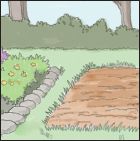
2. Decide whether you will be using a bin after checking on any local or state regulations for composting in urban areas, as some communities require rodentproof bins. There are numerous styles of compost bins available, depending on your needs, ranging from a moveable bin formed by wire mesh to a more substantial wooden structure consisting of several compartments. You can easily make your own bin using chicken wire or scrap wood. While a bin will help contain the pile, it is not absolutely necessary, as you can build your pile directly on the ground. To help with aeration, you may want to place some woody material on the ground where you will build your pile.
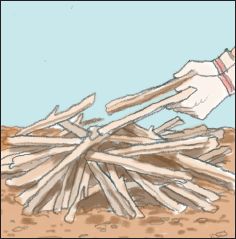
3. Ensure that your pile will have a minimum dimension of 3 feet all around, but is no taller than 5 feet, as not enough air will reach the microorganisms at the center if it is too tall. If you don’t have this amount at one time, simply stockpile your materials until a sufficient quantity is available for proper mixing. When composting is completed, the total volume of the original materials is usually reduced by 30 to 50 percent.
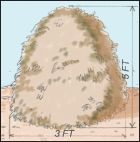
4. Build your pile by using either alternating equal layers of high-carbon and high-nitrogen material or by mixing equal parts of both together and then heaping it into a pile. If you choose to alternate layers, make each layer 2 to 4 inches thick. Some composters find that mixing the two together is more effective than layering. Adding a few shovels of soil will also help get the pile off to a good start because soil adds commonly found, decomposing organisms to your compost.
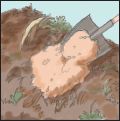
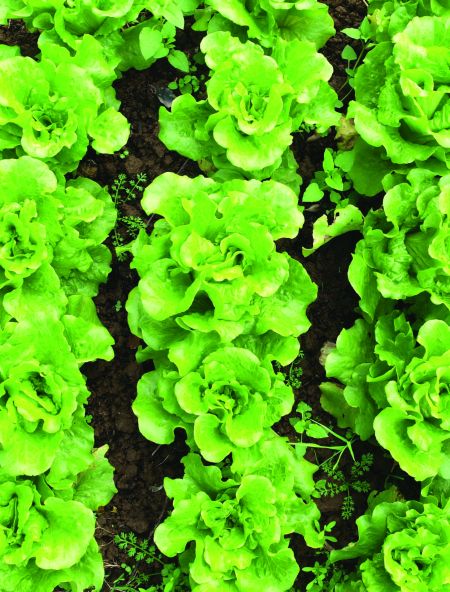
5. Keep the pile moist but not wet. Soggy piles encourage the growth of organisms that can live without oxygen and cause unpleasant odors.
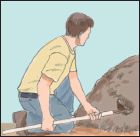
6. Punch holes in the sides of the pile for aeration. The pile will heat up and then begin to cool. The most efficient decomposing bacteria thrive in temperatures between 110 and 160 degrees Fahrenheit. You can track this with a compost thermometer, or you can simply reach into the pile to determine if it is uncomfortably hot to the touch. At these temperatures, the pile kills most weed seeds and plant diseases. However, studies have shown that compost produced at these temperatures has less ability to suppress diseases in the soil, since these temperatures may kill some of the beneficial bacteria necessary to suppress disease.
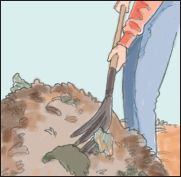
7. Check your bin regularly during the composting season to assure optimum moisture and aeration are present in the material being composted.
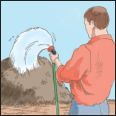
8. Move materials from the center to the outside of the pile and vice versa. Turn every day or two and you should get compost in less than four weeks. Turning every other week will make compost in one to three months. Finished compost will smell sweet and be cool and crumbly to the touch.
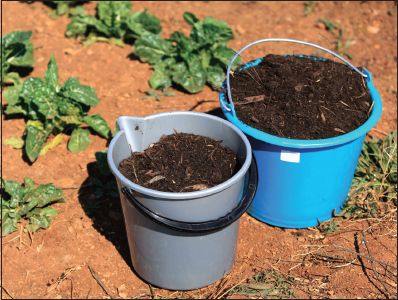
Other Types of Composting
Cold or Slow Composting
Cold composting allows you to just pile organic material on the ground or in a bin. This method requires no maintenance, but it will take several months to a year or more for the pile to decompose, though the process is faster in warmer climates than in cooler areas. Cold composting works well if you are short on time needed to tend to the compost pile at least every other day, have little yard waste, and are not in a hurry to use the compost.
For this method, add yard waste as it accumulates. To speed up the process, shred or chop the materials by running over small piles of trimmings with your lawn mower, because the more surface area the microorganisms have to feed on, the faster the materials will break down.
Cold composting has been shown to be better at suppressing soil-borne diseases than hot composting and also leaves more non-decomposed bits of material, which can be screened out if desired. However, because of the low temperatures achieved during decomposition, weed seeds and disease-causing organisms may not be destroyed.
Vermicomposting
Vermicomposting uses worms to compost. This takes up very little space and can be done year-round in a basement or garage. It is an excellent way to dispose of kitchen wastes.
Here’s how to make your own vermicomposting pile:
1. Obtain a plastic storage bin. One bin measuring 1 foot by 2 feet by 3 ½ feet will be enough to meet the needs of a family of six.
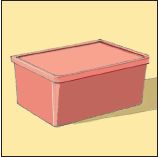
2. Drill 8 to 10 holes about ¼ inch in diameter in the bottom of the bin for drainage.
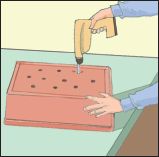
3. Line the bottom of the bin with a fine nylon mesh to keep the worms from escaping.
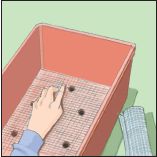
4. Put a tray underneath to catch the drainage.
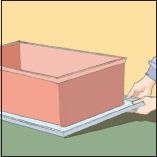
5. Rip shredded newspaper into pieces to use as bedding and pour water over the strips until they are thoroughly moist. Place these shredded bits on one side of your bin. Do not let them dry out.
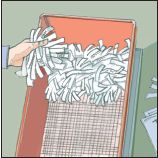
6. Add worms to your bin. It’s best to have about two pounds of worms (roughly 2,000 worms) per one pound of food waste. You may want to start with less food waste and increase the amount as your worm population grows. Redworms are recommended for best composting, but other species can be used. Redworms are the common, small worms found in most gardens and lawns. You can collect them from under a pile of mulch or order them from a garden catalog.
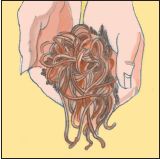
7. Provide worms with food wastes such as vegetable peelings. Do not add fat or meat products. Limit their feed, as too much at once may cause the material to rot.
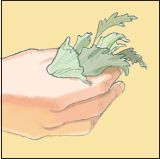
8. Keep the bin in a dark location away from extreme temperatures.
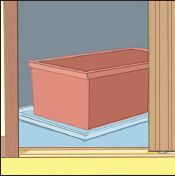
9. Wait about three months and you’ll see that the worms have changed the bedding and food wastes into compost. At this time, open your bin in a bright light and the worms will burrow into the bedding. Add fresh bedding and more food to the other side of the bin. The worms should migrate to the new food supply.
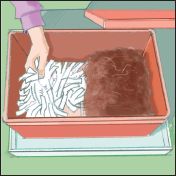
10. Scoop out the finished compost and apply to your plants or save to use in the spring.
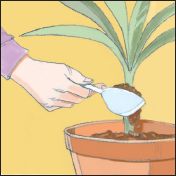
The Junior Homesteader
Let the kids be in charge of feeding the worms in your compost. They’ll be fascinated by the squirmy critters!
Compost Trouble-shooting
Composting is not an exact science. Experience will tell you what works best for you. If you notice that nothing is happening, you may need to add more nitrogen, water, or air; chip or grind the materials; or adjust the size of the pile.
If the pile is too hot, you probably have too much nitrogen and need to add additional carbon materials to reduce the heating.
A bad smell may indicate not enough air or too much moisture. Simply turn the pile or add dry materials to the wet pile to get rid of the odor.
Uses for Compost
Compost contains nutrients, but it is not a substitute for fertilizers. Compost holds nutrients in the soil until plants can use them, loosens and aerates clay soils, and retains water in sandy soils.
To use as a soil amendment, mix 2 to 5 inches of compost into vegetable and flower gardens each year before planting. In a potting mixture, add one part compost to two parts commercial potting soil, or make your own mixture by using equal parts of compost and sand or Perlite.
As a mulch, spread an inch or two of compost around annual flowers and vegetables, and up to 6 inches around trees and shrubs. Studies have shown that compost used as mulch, or mixed with the top 1 inch layer of soil, can help prevent some plant diseases, including some of those that cause damping of seedlings.
As a top dressing, mix finely sifted compost with sand and sprinkle evenly over lawns.